

All Episodes of Bill Nye the Science Guy
Browse all episodes of Bill Nye the Science Guy

All Episodes of Bill Nye the Science Guy
Browse all episodes of Bill Nye the Science Guy
Season 1
 6.4/1035 votes
6.4/1035 votesFlight
Season 1 Episode 1 - Aired 9/10/1993
Things that fly need air. Even though we walk through it, breathe it, and sneeze it, air seems to be a whole bunch of nothing. But air is there, and it's powerful. Balloons inflate because air presses on the insides and outsides of the balloon. Air pressure in tires supports the weight of bikes, buses, trucks, cars, and planes. But air doesn't need to be inside something to exert pressure. Air that moves around pushes, too. What do birds, planes, kites, Frisbees, and helicopters have in common? They fly because moving air creates lift, or a push up. Airplane wings are shaped to push air down. The momentum of the air going down pushes wings up. Air above the wing gets going faster than the air underneath. Fast-moving air zips along, without pushing as hard side to side or up and down. The slow air pushes up from below harder than the fast air pushes down from above ... and you're airborne! Every flying thing, from the tiniest flying insect to the biggest airplane, us
Director: Unknown
Writer: Unknown
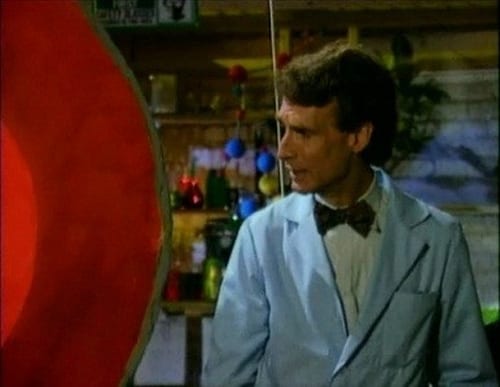 7.2/1050 votes
7.2/1050 votesEarth's Crust
Season 1 Episode 2 - Aired 9/17/1993
Don't just go with the flow. Settle down on the crust. Imagine a world without any crust. There would be no pies, just goopy filling, no bread, no hamburger buns, and no you or me. That's right. You, and every living thing we know of, live on or in the Earth's crust. And, living things need the Earth's crust to survive. Let's look at the science of the surface. By carefully studying the Earth's surface, scientists have discovered that the Earth is made up of gigantic layers. At the center of the Earth, there is a core – a big ball of solid metal mostly iron. The core is surrounded by a layer of liquid iron and other minerals. We usually just call it the outer core. The next layer, around the outer core is called the mantle. You may have seen a mantle above a fireplace. Well, the mantle is above the Earth's hot core places. The mantle is gooey hot nearly melted rock that flows the way asphalt does on a hot summer day. Scientists often say that the mantle is plastic. It
Director: Unknown
Writer: Unknown
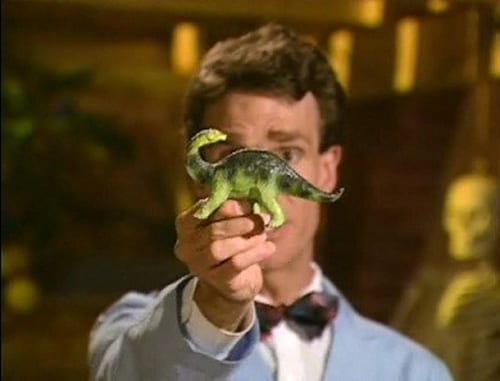 6.6/1033 votes
6.6/1033 votesDinosaurs
Season 1 Episode 3 - Aired 9/24/1993
We can dish the real dirt about dinosaurs, thanks to fossils - traces of theses astonishing animals. Dinosaurs did not print newspapers. They did not take family snapshots or videos 65 million years ago. The only proof scientists have of dinosaurs is their fossils, especially bones. They would never have survived billions of years waiting for some human to trip over them. Luckily for paleontologists (scientists who study the past), now and then dinosaurs died, and their bones were covered by mud, or sand. As the bones sat protected from weather, they absorbed minerals from the soil around them. The minerals chemically worked their way into the bones. Millions of years later, we can find them and dig them up. Humans were not around to see what actually killed the ancient dinosaurs. Many scientists think a meteorite, or lots of meteorites, crashed into the Earth. When the space rocks hit the ground, they made big craters and kicked up a lot of dust and dirt. If enough d
Director: Unknown
Writer: Unknown
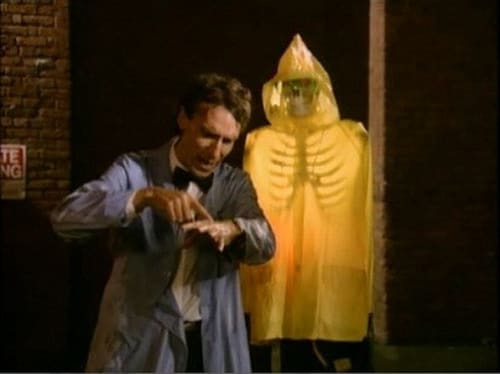 7.3/1020 votes
7.3/1020 votesSkin
Season 1 Episode 4 - Aired 10/1/1993
Learning about skin science is no sweat. It's gigantic. It's gargantuan. It's your skin. It's your body's biggest organ. If you could lay your skin out flat, it would cover about one and a half square meters. Your skin stops you from drying out, protects you from the weather, and keeps bacteria and viruses from getting inside your body. Your skin is also your personal air conditioner and heater all in one. Sweating cools you off. When you're hot, glands in your skin push a mixture of water and other chemicals onto the surface of your skin. When the water evaporates, it takes some of the heat with it, and you're cooler. When you're too cold, your skin muscles start twitching. Shivering makes your body warm up. Without skin, you wouldn't be able to feel the difference between a sheet of paper and a wool blanket. There are thousands of touch receptors inside skin. When you touch the remote control, the receptors send information about the remote's temperature, thicknes
Director: Unknown
Writer: Unknown
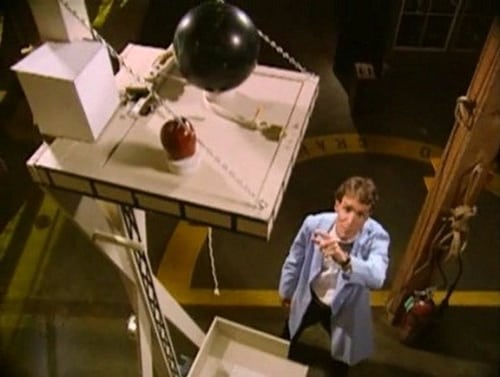 7.3/1026 votes
7.3/1026 votesGravity
Season 1 Episode 6 - Aired 10/15/1993
Next time you throw a ball in the air, and it doesn't fly off into outer space, thank gravity. Right now, you and everything in the room where you are, is getting pulled down by gravity. If you don't believe it, push a book of your desk. It will go plummeting toward the center of the Earth. It's gravity. The Earth's mass, the stuff it's made of, creates gravity. It's pulling down on you and every other object you can see; it's even pulling down on the air and the ocean. Not only that, you and every atom of every thing around you has gravity. So, the objects and atoms are all, ever so slightly, pulling up on the Earth! Without gravity, there would be no weight. When you step on a bathroom scale, the scale is getting squeezed between you and the Earth. The scale measures how strong this mutual attraction is. Gravity makes a force that pulls objects together. Not only is gravity pulling on every atom and molecule of everything around us, it pulls over huge, gigantic di
Director: Unknown
Writer: Unknown
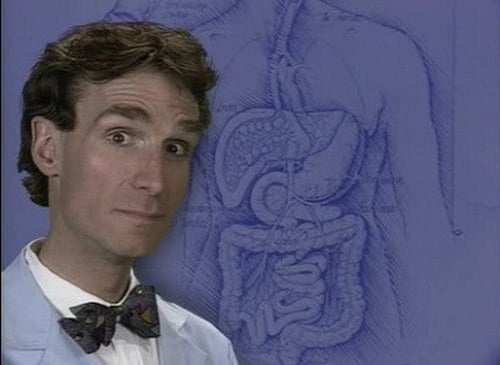 6.8/1020 votes
6.8/1020 votesDigestion
Season 1 Episode 7 - Aired 10/22/1993
Take time to digest this show. They say that your food is no more inside you than a pencil is inside a donut, when it's poked through the hole. Instead of the food going in you, food goes through you. But, all the energy you get to live and grow comes from your food. All the chemicals that become your body and brain as you get bigger, come from your food. You get these vital chemicals through a process called ""digestion."" Your body breaks food down and grabs all the nutrients you need from it. Then, your body gets rid of what's left over. Digestion starts in your mouth. You begin breaking food down by breaking it into pieces with your teeth and jaw muscles. Your saliva (your spit) is full of chemicals that react with the chemicals in food and make them break apart. Then you swallow. Your food goes down a tube (your esophagus) to your stomach, where powerful hydrochloric acid breaks it down further into a mushy mash we call chime (kime). From there, the chime goes in
Director: Unknown
Writer: Unknown
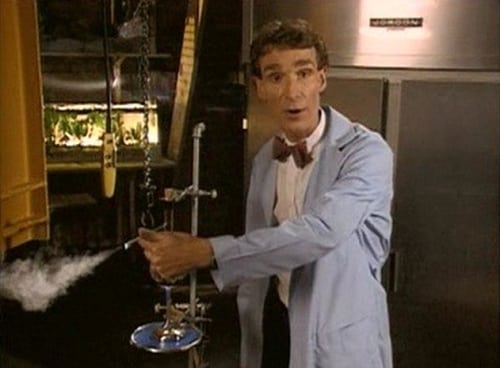 7.2/1017 votes
7.2/1017 votesPhases of Matter
Season 1 Episode 8 - Aired 10/29/1993
Bill Nye is going through a phase - a phase of matter. Check out the ""Phases of Matter"" episode to find out about rock-solid solids, liquidy liquids, and gassy gases. It's phase-tastic! Everything around us is made of stuff called matter, and all matter is made of atoms. Matter is anything that comes in three varieties, what scientists call phases. There are solids like rocks, cookies, and desks. There are liquids like water, honey, and juice. And there are gases, we breathe air and the helium in balloons. The main difference between the three phases is how fast the matter's atoms move. All atoms move around because they have energy. The more energy that's in something, the faster the atoms move. Atoms in an ice cube don't move very much - they're frozen in place. The atoms in liquid water slip and slide around - that's why you can pour it and spill it. Water vapor atoms are moving pretty fast - that's why they float around in air (a mixture of other gasses). Changing
Director: Unknown
Writer: Unknown
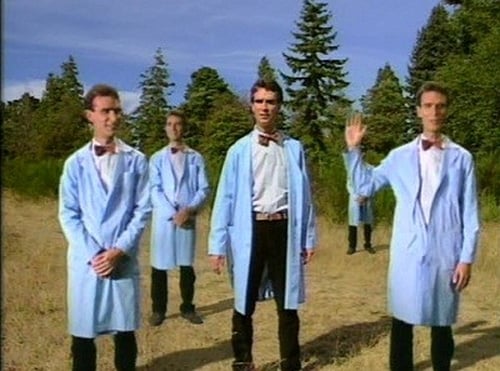 6.1/1016 votes
6.1/1016 votesBiodiversity
Season 1 Episode 9 - Aired 11/5/1993
Ecosystems are areas where things live. Ecosystems that are biodiverse are home to a variety of plants and animals. A healthy ecosystem is one with a lot of biodiversity. Imagine if humans could only eat one kind of food, say corn. We'd be in big trouble if all the corn disappeared. Besides not having anything to munch on at the movies, we'd have nothing to eat at all. Luckily, our ecosystem covers a big part of the Earth, and there are lots of different plants to eat. Ecosystems are not as simple as one living thing eating another, as the corn example. The lives of animals and plants are intertwined - what happens to one animal can have an impact on all sorts of living things. As humans, we have a big effect on the other living things around us. We are the only animals to leave lots of stuff around, such as houses, cars, and malls. It's important for us to think about the choices we make and how they will affect the other living things around us. Remember: The Earth
Director: Unknown
Writer: Unknown
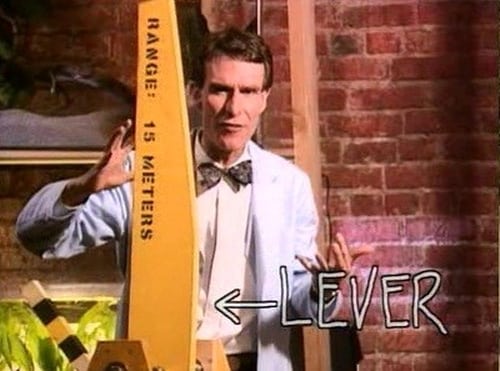 6.4/1013 votes
6.4/1013 votesSimple Machines
Season 1 Episode 10 - Aired 11/12/1993
Learning about science can be hard work, but simple machines can make it easier. Let Bill Nye push and pull you around ramps, levers, screws, and pulleys. Simple machines simply make work easier by directing forces over distances. Instead of lifting a heavy box upstairs, you can hook it to some ropes and pulleys and pull it up. Or you can get a ramp and slide it upstairs. Either way, it's less sweat to use the pulleys or the ramp than it is to lift the box straight up by yourself because the force you need is more spread out. Levers, ramps, screws, wheels, wedges, and pulleys are all simple machines designed to direct forces. With simple machines we don't have to push or pull as hard, but we have to push or pull over a longer distance. It's easier to walk up a long set of stairs to the top of the Empire State Building than it would be to climb a ladder to the top, but the set of stairs would be much longer than the ladder. Simple machines are simply scientific.
Director: Unknown
Writer: Unknown
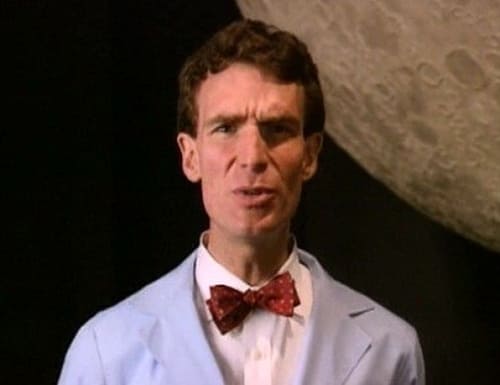 6.3/1012 votes
6.3/1012 votesThe Moon
Season 1 Episode 11 - Aired 11/19/1993
Let the moon master Bill Nye teach you the ancient and not-so-ancient secrets of the Moon. Wax on, wax off. The Moon grows bigger (waxes) and smaller (wanes) every 30 days or so. The word ""month"" comes from the word ""moon"". The Moon is the closest thing in space to Earth, and it's one of the most well-studied orbs in our solar system. We know that Moon rocks are rich in calcium and aluminum, that the Moon has no atmosphere, and that there are over a million craters on the Moon's surface. The Moon doesn't glow on its own, it reflects sunlight. Watch the Moon every night for a month as it grows, shrinks, and at one point disappears. The Moon doesn't actually change it's shape. It's the way the sun shines on the part of the Moon we see that makes the phases change. The Earth moves around the Sun, the Moon moves around the Earth. As the Moon moves through its orbit, the Sun shines on bigger or smaller portions of it. If you were looking at the Moon from the Sun, it woul
Director: Unknown
Writer: Unknown
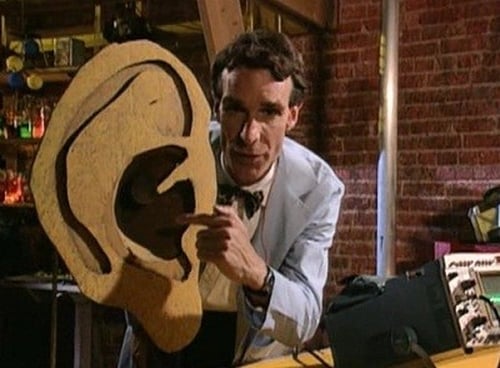 7.0/1013 votes
7.0/1013 votesSound
Season 1 Episode 12 - Aired 11/26/1993
Listen up, scientists. Bill Nye is here to make some noise in the ""Sound"" episode. Your vocal cords do it. Speakers playing rock music do it. Even a school bell does it. They all vibrate; and that's how sound is made. Plucking a stretched rubber band makes the rubber band vibrate. Air molecules around the rubber band move, pushing other air molecules. As the rubber band continues to vibrate, it sends waves of sound through the air. It's a lot like the ripples you see when you drop a rock into a pond. You hear sound when rippling air pushes on tiny bones in your ears. Nerves in your ears send a message to your brain about the sound you're hearing. Different sounds make different patterns of waves with different distances between them. Plucking, banging, whispering, and yelling are all vibrations in air, yet they all sound very different. Sound vibrations can be thought of as waves moving through molecules. Low-pitched sounds have big gaps between waves, while high-pi
Director: Unknown
Writer: Unknown
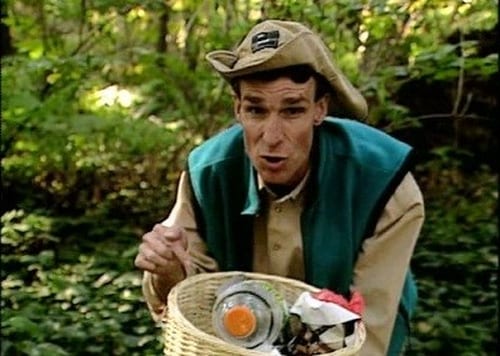 6.7/1012 votes
6.7/1012 votesGarbage
Season 1 Episode 13 - Aired 12/3/1993
Garbage is a look at two different kinds of garbage -- biodegradable and non-biodegradable. Nye emphasizes the importance of recycling and cutting down on the amount of the waste that cannot break down. The music video "Recycle" has a familiar melody, taken from "Respect," the Aretha Franklin hit.
Director: Unknown
Writer: Unknown
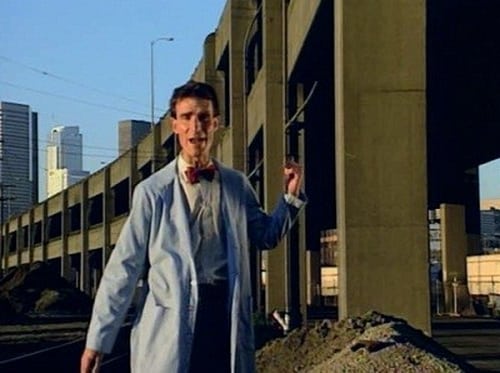 7.5/1012 votes
7.5/1012 votesStructures
Season 1 Episode 14 - Aired 12/10/1993
Are you tense? Need some structure to your life? Then tune in to Bill Nye the Science Guy as he explains the science of structures. All structures give support or create a shape. You can find structures everywhere. Bridges, buildings, chairs, shoes, plants, spiderwebs, tables, and even your own body are all structures. A structure's shape, size, and what it's made of depend on what the structure does and how strong it needs to be. When structures give support, they either experience a pull (tension) or a push (compression). Structures in tension, such as ropes, cables, or blimps are made from stuff that is good at pulling. The materials in tension are usually thin. Structures under compression, such as elephant legs and courthouse columns, are made from hard stiff stuff. Compared to structures under tension, structures under compression are much thicker. When it comes to structures, form (the size and shape) depends on function (what it does). Build support for Bill
Director: Unknown
Writer: Unknown
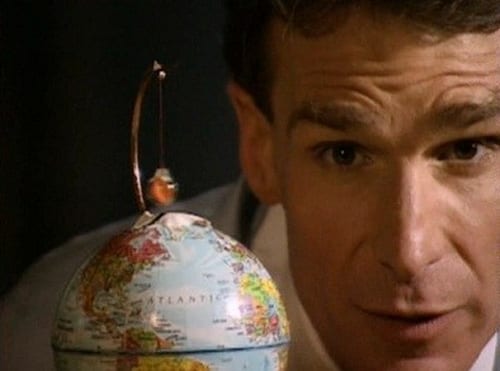 6.7/1012 votes
6.7/1012 votesEarth's Seasons
Season 1 Episode 15 - Aired 12/17/1993
It doesn't matter if it's spring, summer, winter, or fall - Bill Nye is always in season. Every year, we experience the seasons. Some months have snow and rain, while other months have warmth and sunshine. Temperatures go from cold, to woarm, to cold again – winter, spring, summer, and fall. The cycle of the seasons takes one year, and the Earth takes one year to go around the sun. Coincidence? No way. The Earth's orbit around the Sun is flat, as though our planet were spinning over a tabletop. Compared with flat plane of its orbit, the Earth is tilted. Its axis, the imaginary line between the North and South Poles, is tipped over a bit. In June, the north half of the Earth (the Northern Hemisphere) is tilted toward the Sun, and it's summertime in places like Nye Labs in the United States. Meanwhile, the south half (the Southern Hemisphere) is tilted away from the Sun, and it's winter there, in places like Australia and South Africa. The Earth's orbit isn't quite
Director: Unknown
Writer: Unknown
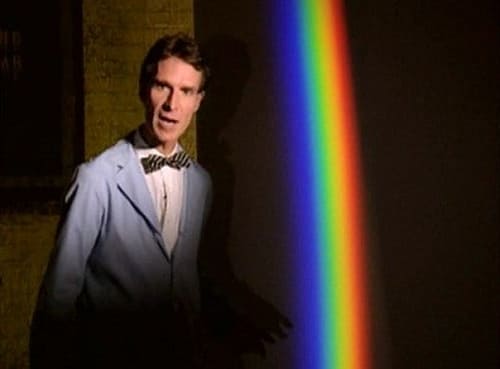 7.6/1017 votes
7.6/1017 votesLight & Color
Season 1 Episode 16 - Aired 12/24/1993
Lighten up. It's the ""Light and Color"" episode. Without light, we wouldn't be able to see. It would be like living in a room with no windows, doors, or lamps. There's an old saying, ""We don't see things; we see light bouncing off of things."" We see things, and colors, when light bounces off things and into our eyes. White light, like the light from the Sun, is made up of all the different colors of light blended together. When white light hits something white, almost all of the light bounces into our eyes, and we see the color white. Things are different colors because some light bounces off and other light gets absorbed. An orange is orange because it absorbs all different colors of light except orange light. Grass is green because it absorbs all different colors of light except green light. Bill Nye's lab coat is blue because it absorbs all different colors of light except blue light. All colors, including black, are made in the same way. It's just a matter of ref
Director: Unknown
Writer: Unknown
 6.7/1015 votes
6.7/1015 votesCells
Season 1 Episode 17 - Aired 1/21/1994
You can't see them, but they're everywhere even inside Bill Nye. This is not science fiction, it's the science of cells. All things that live are made from cells. You can't see them, but every part of your body, including everything inside your body, is made from cells. Cells eat, they grow, and they make more of themselves (what scientists call replicate). There are millions of different types of cells. Dog cells are different from fish cells. Bird cells are different from your cells. And inside your body, there are many different cells, each one doing a different job to keep your body going. Cells may be tiny, but without them, we'd be nothing.
Director: Unknown
Writer: Unknown
 7.3/1016 votes
7.3/1016 votesElectricity
Season 1 Episode 18 - Aired 1/28/1994
It's time for Bill Nye to shed a little light on electricity. Electricity might seem mysterious, but once you understand the science the light goes on (so to speak). You flip a switch, and the lights turn on. You push the play button, and your personal stereo starts playing music. When you flip the switch or push play, you start a flow of electrons. Electricity is the flow of electrons, and electrons are very tiny charged particles. Electrons are found in atoms, the tiny pieces that all stuff is made from. We can make electrons flow in two ways. Batteries make electricity by mixing up chemicals -- making a chemical reaction that forces electrons to move in a path from the battery to the personal stereo and back to the battery. Electricity that turns on lights in your home is made by power plants. Most power plants use big machines called generators to make electrons by twirling wire in a magnet. The magnet makes electrons in the wire move around, creating electricity.
Director: Unknown
Writer: Unknown
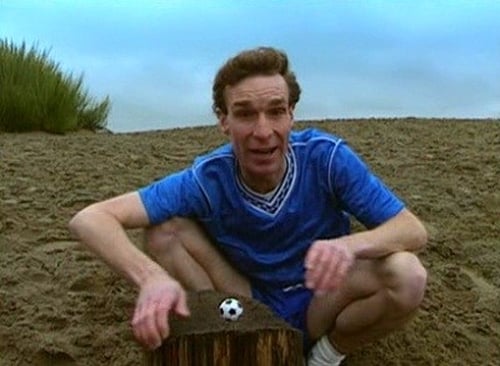 7.2/1017 votes
7.2/1017 votesOuter Space
Season 1 Episode 19 - Aired 2/4/1994
The show is way out there, way far away. After all, it's in Outer Space. When you look at the night sky on a clear dark night, you can see thousands of stars. There are far more than you could count. And, they are way out there. They are very, very far away. It's about the hardest thing to imagine about space. Let's talk about the nearest star to us, the Sun. If somehow outer space were not an icy cold vacuum with nothing to eat, drink, or breathe, and we could drive there in a car, to get to the Sun at freeway speed of 100 kilometers/hour (61 miles/hour), it would take171 years of driving without stopping to sleep or get gas out in the near nothingness of space. That's just to the Sun. To get to even the closest star, Proxima Centauri, would take 40,000 years. On top of that, most things, billions and billions of stars, are much, much farther away than that! It is just astonishing. How do we know that everything is so far away? We have watched the sky for centuries.
Director: Unknown
Writer: Unknown
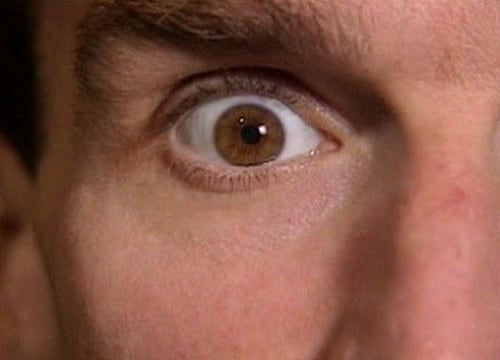 7.4/1015 votes
7.4/1015 votesEyeball
Season 1 Episode 20 - Aired 2/11/1994
Look no further ... Bill Nye is on the ball - the eyeball. For their small size, your eyes do an important job. By working with your brain, your eyes can tell the difference between thousands of different colors. They can follow a fast-moving hockey puck across the ice. They are even sending messages to your brain about what you're reading right now. Eyes work a lot like a camera. They take in light, focus light, and make images. With help from the brain, your eyes help understand the world around you. Light bouncing into your eye passes through an opening called the pupil. If you look in the mirror, your pupil is the black area in the middle of your eye. The pupil can open or close, depending on the brightness of the light. After passing the pupil, the light is focused onto the back of your eye by the lens, a thin layer of cells. On the back of your eye are special cells called rods and cones that are sensitive to light. These cells send electrical messages to your
Director: Unknown
Writer: Unknown
